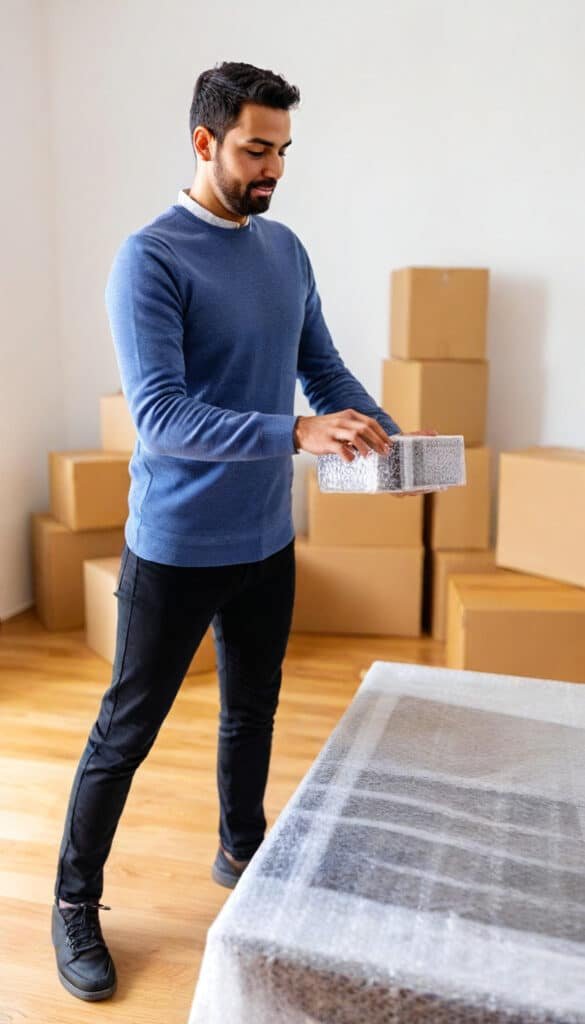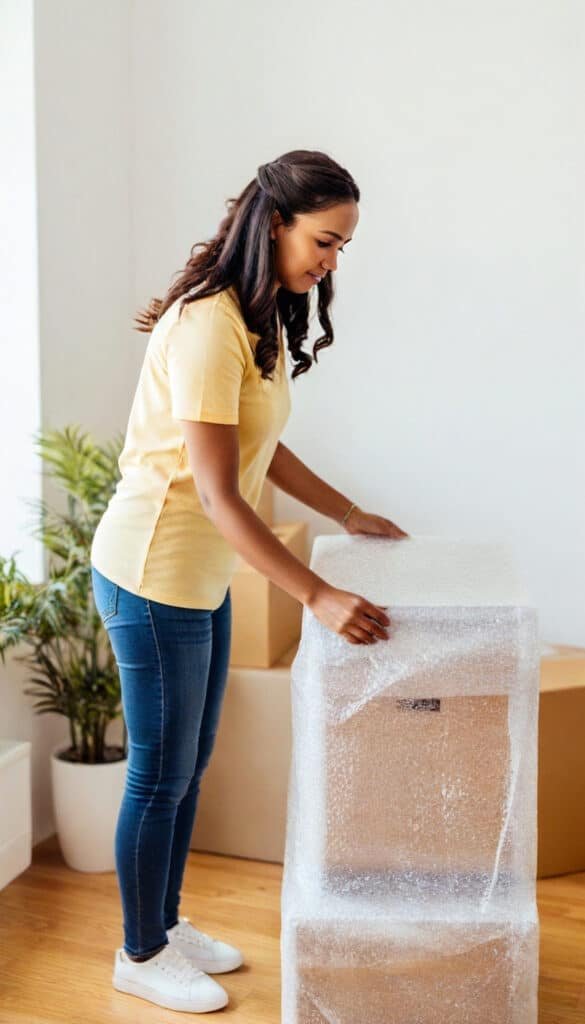Moving companies charge $25 to $40 per item to pack artwork. The costs pile up fast with twenty or thirty pieces. Packing artwork yourself saves money, and you can achieve professional results with the right techniques.
Picture boxes protect valuable artwork during moves. These boxes come in sizes from 14 x 19 x 2 inches up to 59 x 59 x 4 inches. A single box costs around $55, while ten or more boxes cost about $352. Specialized containers protect your valuable pieces effectively. Bubble wrap and foam sheets play a significant role in packing paintings safely during moves.
Let me share some professional packing methods in this piece that moving companies rarely reveal. These techniques will help your cherished artwork arrive safely at your new home. You’ll learn the best ways to wrap delicate frames and pack art securely for transport.
Gathering the Right Supplies for Artwork Packing
You’ll need specific supplies to protect your artwork properly. Art pieces need special materials to prevent damage during moving, unlike regular household items.
Bubble wrap, glassine paper, and plastic wrap
Bubble wrap gives excellent cushioning and stops movement during transit. Large bubbles work best when they face outward, away from delicate artwork surfaces. Your paintings, especially watercolors or delicate pieces, need acid-free paper or glassine wrapping. Glassine paper stands out because it’s PH neutral and blocks air, water, and grease. Artwork without a glass covering needs several layers of plastic kitchen wrap or palette wrap to shield painted surfaces from other packing materials.
Choosing the right size boxes and crates
The right container size plays a vital role in artwork protection. Double-walled boxes should have at least two inches of space on each side of your artwork for padding. Large, fragile, or oddly shaped pieces might need custom wooden crates that match your artwork’s exact dimensions. These crates cost more than standard boxes but will give superior protection.
Corner protectors and foam sheets
Framed artwork’s corners need extra care as they break easily. Foam or cardboard corner protectors fit tightly onto canvas sides and framed artwork to shield them from damage. Biyomap makes reusable foam edge protectors in different sizes (25x35mm, 35x45mm, 45x60mm) that replace environmentally harmful bubble wrap. Archival foam sheets make great cushioning materials that you can cut to fit your artwork’s specific dimensions.
Labeling tools and markers
Good labeling matters as much as physical protection. Mark all sides of your package as “Fragile” with permanent markers and write what’s inside and where it goes in your new home. This helps handlers know they need to be extra careful with these valuable items.
Getting these supplies ready before you start packing will help move your precious artwork safely without damage.
Step-by-Step Guide to Packing Artwork Safely
Your supplies are ready, so let’s take a closer look at the actual packing process. How to pack artwork for moving requires specific steps that professional art handlers use.
Apply painter’s tape in an X across glass surfaces
The first step is placing painter’s tape in an X pattern across the glass-covered artwork. This significant first step helps minimize damage if breakage occurs and keeps glass shards from scattering. Painter’s tape works better than masking tape because it leaves less residue and won’t damage the glass surface.
Use glassine paper to protect painted surfaces
Each piece needs individual wrapping with glassine paper to protect against moisture, dirt, and fingerprints. This special acid-free paper won’t stick to painted surfaces, which makes it perfect for shipping paintings. Acid-free tissue paper can work for prints when glassine isn’t available, though it doesn’t protect as well.
Wrap with bubble wrap and secure with tape
The next layer is bubble wrap around your artwork. The bubbles should face outward to avoid leaving marks on delicate surfaces. The wrap should be tight enough for cushioning but not so tight that it presses the painting. Low-stick packing tape secures all edges without touching the artwork.
Add cardboard or foam layers for extra protection
Your wrapped artwork needs protection between two pieces of foam board or cardboard cut slightly larger than the piece. This rigid protective shell stops bending and puncturing. Large cardboard pieces between each wrapped item keep multiple artworks of similar size separated.
Place in a box with cushioning at the bottom and sides
The box needs a cushioned base of crumpled packing paper or foam. The sandwiched artwork slides gently into the box and should fit snugly without moving. Additional packing material fills any gaps to prevent shifting during transport. Strong packing tape seals the box, with reinforced corners for extra durability.
Special Techniques for Different Types of Art
Different types of artwork demand unique packing methods. Let’s look at the best techniques you need for each art form.
How to pack framed artwork for moving
Artwork with glass frames needs special care. Start by applying painter’s tape in an X pattern across the glass front to prevent shard scattering if breaks occur. The piece should be wrapped in packing paper and secured with bubble wrap that cushions all sides. Cardboard inserts placed on both sides of the glass create a protective barrier between the front and other materials. The wrapped piece should fit snugly inside picture boxes specifically designed for artwork.
Best way to pack canvas paintings
Canvas paintings can easily tear or puncture, so they need specific protection. The painting’s edges must be completely covered with acid-free parchment paper. Bubble wrap should never touch painted surfaces directly because it leaves impressions and traps moisture. Plastic wrap serves as the first layer, followed by bubble wrap on the outside. Long-distance moves require the wrapped canvas to be placed between two foam boards to stay flat and prevent warping.
Tips for packing oversized or oddly-shaped pieces
Custom wooden crates provide maximum protection for oversized or uniquely shaped artwork. The piece’s vulnerable parts need extra attention:
- Cling wrap covers delicate features with rolled bubble wrap reinforcement
- A cushioned “egg” shape surrounds the entire piece
- Foam or wadded paper lines the crate before artwork placement
Packing multiple framed pictures in one box
Multiple framed pieces need bubble wrap layers between them to avoid contact. The box should hold frames vertically—never flat—and similarly sized pieces prevent pressure points. Crumpled paper fills empty spaces to keep frames from moving during transit.
Loading, Transport, and Unpacking Tips
Your artwork needs proper loading and transport after packing. The way you arrange pieces in a moving truck determines if they arrive in perfect condition or get damaged.
How to position artwork in the moving truck
Load your artwork upright instead of flat. You should place boxes near the top to prevent crushing from heavy items below. The best protection comes from positioning artwork between stable furniture that stays put during transit. Use straps or bungee cords to keep everything secure while driving.
Why vertical placement matters
Vertical positioning spreads pressure evenly across the frame and prevents stress points. Your artwork can break or warp if you place it horizontally with objects stacked on top. Just like books on a shelf, paintings handle pressure better when they stand upright rather than lying flat.
Unpacking quickly to avoid moisture damage
Start unpacking your artwork right away after arrival. Wrapped paintings face serious risks from moisture that can lead to mold, cracking paint, or warped canvas. Your collection stays in the best condition when indoor temperatures range between 65-75°F with humidity at 40-60%.
Inspecting for damage and filing claims
Take photos while unboxing your artwork. Document any damage from multiple angles and compare with pictures from before the move. The moving company needs to know right away – they have 30 days to acknowledge claims and 120 days to resolve them. Wait for the claim process to end before attempting repairs.
Conclusion
You can save a lot of money by packing artwork yourself and ensuring your precious pieces arrive safely at your new home. This piece shares professional techniques that moving companies rarely tell you about. These methods will strengthen your ability to handle this delicate task with confidence. The right supplies make all the difference – from glassine paper to corner protectors – between damaged artwork and perfectly preserved pieces.
Different types of artwork just need specific approaches. Canvas paintings must be protected against tears and punctures. Your framed pieces’ glass surfaces require extra care. The way you position art during transport is as vital as the original packing process. Placing pieces vertically helps distribute pressure evenly and protects your art from stress during transit.
Make unpacking artwork your top priority once you reach your destination. Your valuable collection faces risks from moisture damage if pieces stay wrapped too long. The process takes time and attention to detail. Still, you’ll feel satisfied knowing you transported your cherished artwork safely without paying professional prices.
These insider techniques let you pack even your most valuable pieces confidently. The money you save – hundreds of dollars for multiple pieces – definitely makes it worth the effort. Best of all, you’ll know your irreplaceable artwork received the same expert care that professional art handlers provide.



